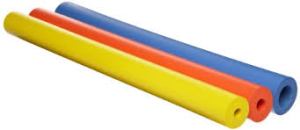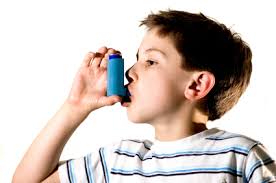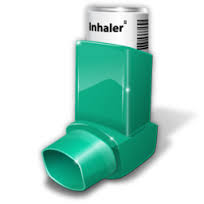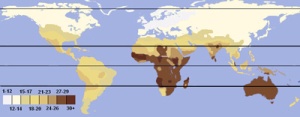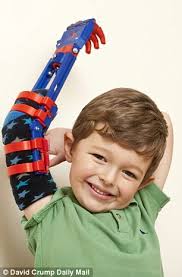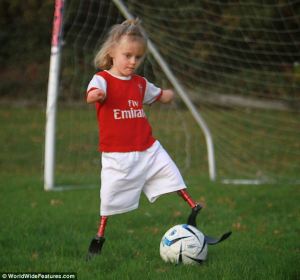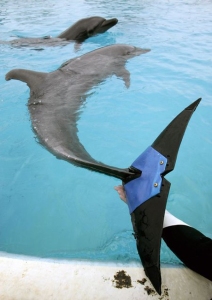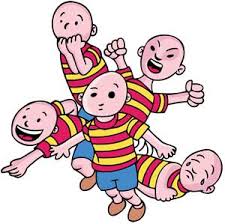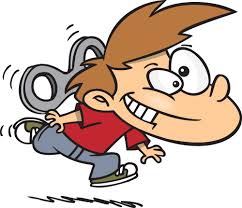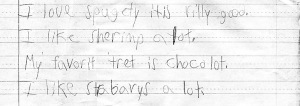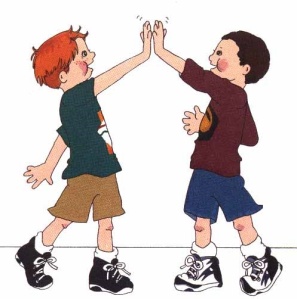Hi everyone! Today I have decided to switch things up a little bit. The past couple of weeks we have learned about mental illnesses, or problems that kids may have with learning or with their brains. Today we are going to learn about a very interesting physical condition. Physical conditions are problems with the body that you can see. For example, it might be a missing leg, or perhaps not being able to walk. The physical condition we are going to learn about today is called Spina Bifida (spy-nah beh-feh-dah). Can anyone guess what part of the body it affects? If you guessed the back or backbones, then you are right!
~The Spine and Spinal Cord
Before we talk about spina bifida, I am going to tell you a little bit about the backbones so you can understand what this condition is. Doctors call the backbones the spine. The spine has 33 different bones called vertebrae (ver-teh-bray) that look like hollow disks with pointy sticks coming out of them. When all of these hollow bones are stacked up they form a long hollow tube called the spine.
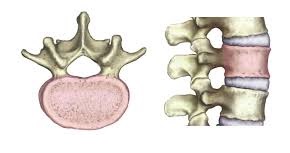
PICTURE A: The left picture is a backbone (vertebrae), and the right picture is how they look from the side when they are stacked up.
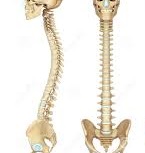
PICTURE B: This is how the spine looks. The left is how it looks from the side, and the right is how it looks from the front.
Why do you think these bones are hollow inside? The spine is hollow in the middle because the spinal cord goes inside. Have you heard about the spinal cord? If not, it is a like a long rope of nerves that go from your brain out to all of the different parts of your body. And just in case you are wondering what nerves are, they are like long strings that your brain uses to tell your body what to do, and that your body uses to tell your brain what is happening. Kind of like when you play telephone with two cups tied together by a long string! Pretty cool right? Going back to the backbones, do you see in PICTURE A in the drawing on the left how the hole in the middle is completely closed? This is because the backbones protect the spinal cord. When the bones are stacked up together they make a strong tunnel that protects the rope of nerves from being hurt (PICTURE B).
I hope you were able to understand all of that. All you really need to know is: The backbone is supposed to be a long, strong tunnel that protects your spinal cord from getting hurt. Imagine a bead necklace; the beads are the back bones and the special fancy string is the spinal cord.
~What is Spina Bifida?
Now that we know some cool facts about the spine, I am going to tell you about spina bifida. Spina bifida is a problem that happens when those backbones are not completely closed. This makes the long tunnel have holes in it. So imagine the bead necklace again, but this time some of the beads are cracked on one side. If a bead is cracked, the special fancy string might be able to slip out and get ripped, right? This is what spina bifida is. The spinal cord is not protected 100% by the bones that surround it, so it can get hurt easily.
~Can you see Spina Bifida?
Sometimes, you can see the spina bifida, but it depends on what kind of spina bifida the child has. Spina bifida can be seen on the backs of kids who have it.
~What are the types of Spina Bifida and how do they look?
There are three types of spina bifida.
- The first type happens when a bone of the spine is not fully closed, but the spinal cord stays inside where it should be. With this type you might be able to see a little dimple on the back (kind of like the cute dimples on your cheeks) and maybe a little patch of hair.
- Necklace example: Even though some of the beads might be cracked, the special fancy string stays inside.
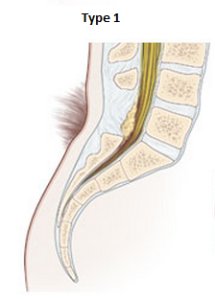
First type: You can see the missing bone (the missing pink circle) and the patch of hair directly over it. The patch of hair is on the child’s back.
- The second kind happens when a bone of the spine is not 100% closed and you can see a type of bubble on the back. This bubble is filled with a liquid called spinal fluid. Everyone has this liquid in their backbone to protect the spinal cord, but since it has a hole in it, it forms a bubble outside on the back.
- Necklace example: A bead from the necklace is cracked, but the special fancy string stays inside the bead. However, the water that is inside the bead comes out and fills a balloon. You would be able to see this balloon on the person’s back.
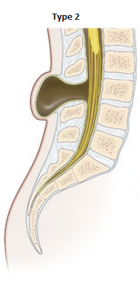
Second type: The “balloon” or “bubble” can be seen on the child’s back, but the spinal cord (the yellowish-brown part) is not in the bubble.
- The third type is like the second kind, but instead of only having liquid in the bubble there are also parts of the spinal cord inside. This kind of spina bifida can be very dangerous for the person who has it, and many kids with this condition may not be able to move at all.
- Necklace example: A bead is cracked so the water inside the bead fills a balloon on the child’s back, but the special fancy string also slips into the balloon.
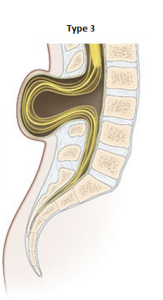
Third type: The “balloon” or “bubble” can be seen on the child’s back, and the spinal cord (the yellowish-brown part) is also in the bubble.
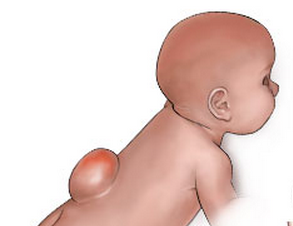
This is what type 2 and type 3 look like from the outside. That bump is the bubble that forms with the liquid and sometimes the spinal cord.
~What problems does spina bifida cause?
There are lots of disabilities that spina bifida can cause. Disabilities are problems.
- Some problems a kid with spina bifida might have is that they may not be able to walk or move at all.
- If they have the third type of spina bifida, they might also have problems learning, speaking, or having a conversation with others.
- Sometimes a kid with spina bifida might not be able to go to the bathroom by themselves. This means they either:
- can’t pee and/or poo when they want to (kind of like when you eat too much and get a tummy ache and you can’t poo, or maybe it’s really hot outside but you didn’t drink any water so you can’t pee)
- or can’t hold in their pee and/or poo (like when you get diarrhea or when you drink too much water and can’t make it to the bathroom)
Even though spina bifida can cause all of this, most of the people that have it may not have any of these problems. They may live normal lives just like you and me!
~What causes spina bifida?
No one knows what causes spina bifida, not even doctors. Some scientists have done experiments and think it may be caused because the mom of the child with spina bidida did not get enough Vitamin B when she was pregnant. However, this does NOT mean it was the mom’s fault that a kid has this condition. Remember, scientists “think” this might be a reason, but do not “know” for sure.
~Can it be cured?
This is hard to answer. Spina bifida can be treated, but it can’t be fixed. What I mean is that a kid with spina bifida can get surgery done to put the spinal cord inside the backbone and fix the opened backbone (put the fancy special string back inside the cracked bead and fix the bead so it is not cracked anymore), but they cannot fix any damage done to the spinal cord (if the special fancy string was torn a little bit or completely ripped, it cannot be fixed even if it is put inside the bead again). So in easier words, you can protect the special fancy string from getting more hurt, but if it already got hurt you can’t fix it.
~How can you help a kid with spina bifida?
- Be friendly: I think this is the most important. If they have a hard time going to the bathroom or if they can’t hold their pee or poo in, don’t make fun of them. Wouldn’t you get embarrassed if someone made fun of you if you accidentally peed your pants? They get embarrassed too, and every time it happens to them it’s on accident. Remember, they might not be able to hold it in or let it out as easily as you can.
- Be Kind: If they have a hard time walking or are in a wheelchair, you shouldn’t make fun of them for that either. Have you ever played in the snow? If you have, you know your legs get really really cold so you have a hard time moving them or feeling your legs. When this happens you have a hard time walking and end up wobbling like a cute little penguin or maybe you trip. That is how it is for a kid with spina bifida all the time. If they are walking slow, be friendly and wait for them or walk at their speed. Also, if they have a patch of hair on their backs, be respectful and don’t make fun of it. That is where their spina bifida is at.
- Be helpful: As we have learned, spina bifida is a physical disability. This means that they may have a hard time walking, picking up heavy things or things from the ground, or reaching things if they are in a wheelchair. If they ask for help, or if you see them struggling a lot, lend a hand! Everyone loves a helping hand, even you! You’ll make them feel happy because someone helped them, and you’ll feel happy too because you did something good for someone!
- Be careful: When you are playing with your friend with spina bifida, be careful not to hurt their backs. Remember, this is where they have their spina bifida. Most likely your friend already had surgery as a baby to put the spinal cord inside their backbone or fix the spina bifida, but you should still be very careful so that they do not get hurt more. You can play, laugh, and have fun, but try to stay away from rough housing.
Spina bifida is not contagious or dangerous. Kids with spina bifida are like strong warriors, and are amazing friends! There is nothing scary or nasty or funny about spina bifida. Kids who have it are just like you a me, and are great people to hang out with! So, what are some other things you could do to help a friend with spina bifida?
Did you know? The body uses hair to protect itself. Depending on where it is, it can be used as a filter to prevent dirt and bacteria from betting inside the body (for example the nose, the tongue, and ears), or as a cushion to prevent the skin from getting a rash (for example the butt cheeks. Yes, everyone has hairy butt cheeks to prevent the skin from hurting since we spend a lot of time sitting). There is even hair inside the body! The hair inside your body is very small and different from the kind on your head, but it is used to prevent dirt and bacteria from getting into your lungs or your stomach.
Last Post:
~ADD and ADHD
Resources:
~Spina Bifida Association
~National Institute of Neurological Disorders and Stroke | Spina Bifida Fact Sheet
~Continence in Spina Bifida


